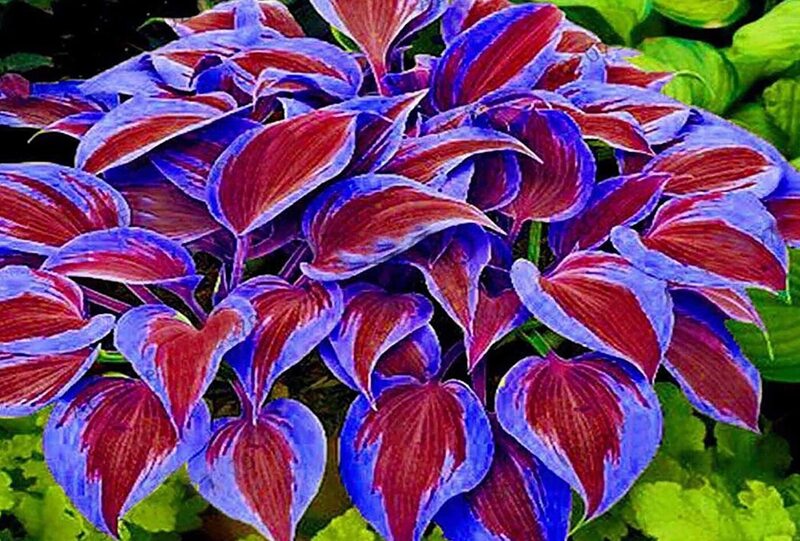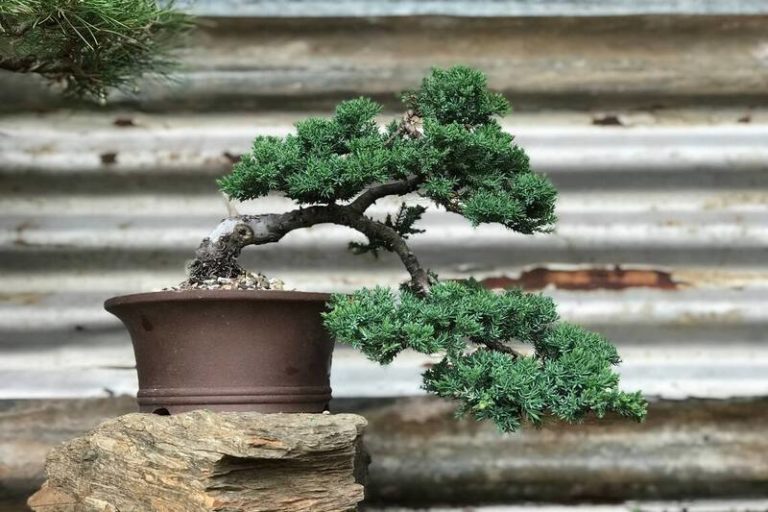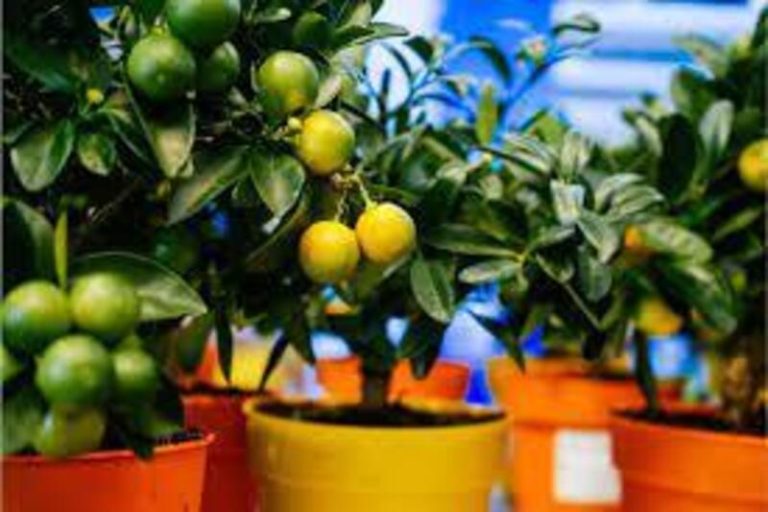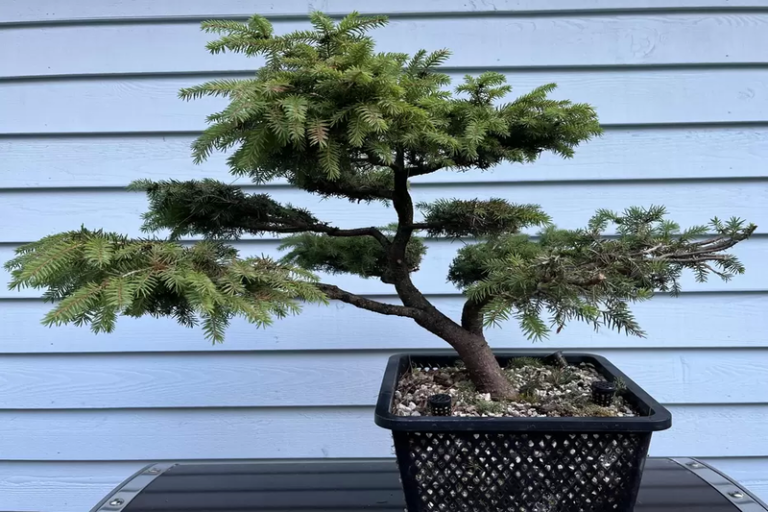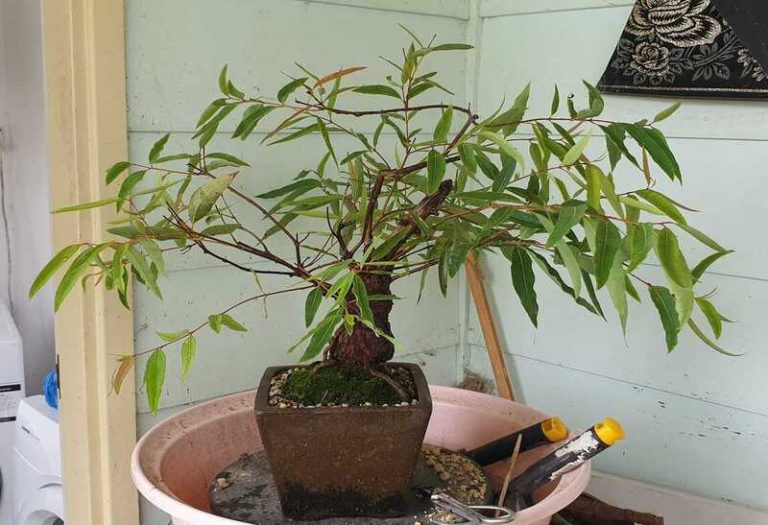Bonsai Hosta: A Unique Twist on a Classic Plant
Bonsai Hosta is a small form of the popular Hosta plant that has been changed for bonsai gardening. The art of bonsai farming is growing small trees in pots. Bonsai Hosta is a great choice for bonsai gardening because it is easy to take care of and has pretty leaves that look good in small pots.
What is Bonsai Hosta?
Bonsai Hosta is a type of miniature plant that has been adapted for bonsai gardening. Bonsai gardening is the art of growing small trees in containers, and Bonsai Hosta is a popular choice because of its compact size and unique appearance.
Usually, people grow Hosta plants for their pretty leaves, and Bonsai Hosta is no different. It needs the same care as other Hosta plants, but its small size makes it a great choice for places inside or outside where a bigger plant might not fit. Bonsai Hosta can be grown in many different shapes and styles, which makes it a useful plant to have in a bonsai collection.
History and Origins of Bonsai Hosta
Bonsai horticulture is an ancient Chinese art form that dates back more than 2,000 years. The Japanese refined the practice of growing diminutive trees in small containers into the art form we recognize today.
The history of Bonsai Hosta can be traced back to Japan in the mid-20th century. Hosta plants were originally cultivated for their ornamental leaves, and bonsai enthusiasts saw an opportunity to adapt the Hosta plant for bonsai gardening. They began experimenting with different Hosta varieties and discovered that some varieties were better suited for bonsai than others.
Bonsai Hosta cultivation has become increasingly popular over time, with numerous nurseries and horticulture enthusiasts specializing in the practice. Today, Bonsai Hosta is a distinctive and aesthetically pleasing addition to any bonsai collection, and it continues to acquire popularity among bonsai enthusiasts worldwide.
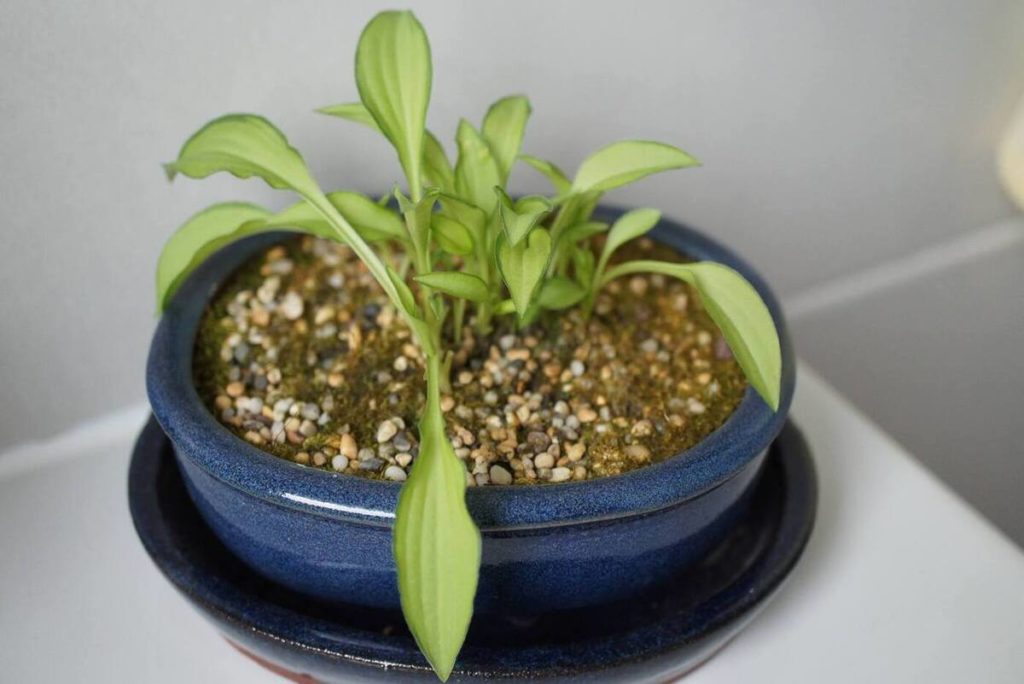
Types of Bonsai Hosta
There are several types of Hosta plants that are suitable for Bonsai gardening. These varieties have been selected for their small size, compact growth habit, and attractive foliage, which make them ideal for growing in small containers. Here are a few examples of Bonsai Hosta varieties:
Hosta ‘Blue Mouse Ears’: This Hosta variety is a popular choice for Bonsai gardening because of its small size and unique blue-green foliage. It grows to a height of only 6–8 inches and has a spread of 12–16 inches.
Hosta ‘Golden Tiara’: This Hosta variety has golden-yellow leaves with green edges, making it an attractive addition to any Bonsai collection. It grows to a height of 8–12 inches and has a spread of 20–24 inches.
Hosta ‘Mini Skirt’: This Hosta variety has small, round leaves that are green with a yellow margin. It grows to a height of 8–12 inches and has a spread of 16–20 inches.
Hosta ‘Tiny Tears’: Leaves of this Hosta cultivar are small and teardrop shaped; they are green and have a white edge. Height is only 4–6 inches, while width is 6–8 inches.
Hosta ‘Dragon Tails’: This Hosta variety has unique, pointed leaves that resemble dragon tails. It grows to a height of only 6–8 inches and has a spread of 10–12 inches.
Many more Hosta plant kinds are also suitable for Bonsai cultivation, thus this is by no means an exhaustive list. The size, growth pattern, and leaf features of a Hosta variety should all be taken into account when choosing it for use in Bonsai gardening.
Bonsai Hosta and its Symbolism
Bonsai Hosta is a unique and beautiful plant that can hold different meanings and symbolism, depending on the cultural or personal context. Here are a few examples of how Bonsai Hosta can be interpreted symbolically:
- Endurance and resilience: As with all bonsai trees, Hosta bonsai requires a great deal of care and attention to remain healthy and develop. This represents the qualities of perseverance and resiliency, as the plant thrives despite adverse conditions.
- Beauty and elegance: Hosta plants are prized for their attractive foliage and unique patterns, making them a popular choice for gardeners and landscapers. Bonsai Hosta, with its small size and intricate growth habit, can symbolize beauty and elegance in miniature form.
- Tranquility and harmony: Bonsai gardening is often associated with meditation and mindfulness, as the process of caring for a bonsai plant requires focus and attention to detail. Bonsai Hosta, with its calming and soothing appearance, can symbolize tranquility and harmony in the natural world.
- Creativity and artistry: Bonsai gardening is a form of artistic expression, as the gardener carefully shapes and prunes the plant to create a unique and beautiful form. Bonsai Hosta, with its versatility and adaptability to different shapes and styles, can symbolize creativity and artistry in the world of gardening.
These are just a few examples of how Bonsai Hosta can hold symbolic meaning. Ultimately, the interpretation of Bonsai Hosta’s symbolism is up to the individual, and the plant can hold different meanings for different people based on their experiences and cultural background.
Characteristics of the Bonsai Hosta
Bonsai Hosta is a unique and attractive plant with a number of distinctive characteristics. Here are a few key features that define the Bonsai Hosta:
Small size: The Bonsai Hosta is a diminutive plant adapted for bonsai horticulture. It grows to a height of only a few inches and has a confined growth habit, making it ideal for indoor or outdoor spaces where a larger plant may not be able to accommodate.
Attractive foliage: Hosta plants are prized for their foliage, and Bonsai Hosta is no exception. It has a wide range of leaf shapes and colors, including blue-green, yellow, and variegated patterns.
Slow growth: Bonsai Hosta grows slowly, which is an important characteristic for bonsai gardening. This allows the gardener to shape and prune the plant over time to create a unique and attractive form.
Versatility: Bonsai Hosta can be grown in a variety of different shapes and styles, making it a versatile addition to any bonsai collection. It can be trained into a traditional bonsai shape or allowed to grow more naturally for a more organic look.
Low maintenance: Hosta bonsai requires consistent irrigation, fertilization, and pruning. However, it is less demanding than other bonsai plants and is an excellent option for novices.
Overall, Bonsai Hosta is a distinctive and beautiful plant that offers a number of benefits for bonsai cultivation. Its compact stature, attractive foliage, slow growth, adaptability, and low maintenance make it a worldwide favorite among bonsai enthusiasts.
How to Grow a Bonsai Hosta
Growing a Bonsai Hosta can be rewarding and enjoyable for cultivators of all skill levels. Here are some fundamental procedures to assist you in getting started:
- Choose the right hosta plant: Any gardener, regardless of skill level, may find success growing Bonsai Hostas and enjoy the process. The following are some basic steps that should help you get going:
- Choose a container: Hosta bonsai can be cultivated in a variety of containers, including traditional bonsai pots, shallow dishes, and even repurposed teacups or basins. Make certain the container has sufficient drainage openings and is large enough to accommodate the plant’s roots.
- Plant the hosta: Fill the container with a well-draining soil mixture and plant the hosta in the center. Make sure the plant is positioned so that the soil level is just below the rim of the container.
- Water the plant: Bonsai Hosta needs regular watering to keep it healthy and hydrated. Water the plant thoroughly, making sure to saturate the soil, but be careful not to overwater, as this can cause root rot.
- Fertilize the plant: Bonsai Hosta benefits from regular fertilization to promote healthy growth and foliage. Use a balanced fertilizer during the growing season (spring through fall) and reduce or eliminate fertilization during the winter months.
- Prune the plant: Bonsai Hosta needs regular pruning to maintain its shape and size. Use sharp pruning shears to remove any unwanted or overgrown branches or leaves, being careful not to damage the plant.
- Train the plant: Bonsai Hosta can be trained into a variety of different shapes and styles using wiring or other techniques. Be patient and take your time as you work to shape the plant, making small adjustments over time to achieve the desired result.
Overall, growing a Bonsai Hosta requires regular care and attention, but with proper care and maintenance, you can create a beautiful and unique addition to your bonsai collection.
Benefits of Bonsai Hosta
Bonsai Hosta is a unique and attractive plant that offers a number of benefits for gardeners and bonsai enthusiasts. Here are a few of the key benefits of growing Bonsai Hosta:
Aesthetic appeal: Bonsai Hosta is prized for its attractive foliage and unique growth habit, making it a beautiful and eye-catching addition to any indoor or outdoor space.
Low maintenance: Bonsai Hosta is a low-maintenance plant that requires regular irrigation, fertilization, and pruning but is less demanding than other bonsai plants.
Versatility: Bonsai Hosta can be trained into a variety of different shapes and styles, making it a versatile addition to any bonsai collection.
Stress relief: It has been demonstrated that gardening, and bonsai gardening in particular, can assist to relieve stress by reducing tension and fostering calm.
Educational value: Taking care of and growing bonsai hosta may be a terrific method to learn about horticulture and plant biology, as well as to gain a better understanding of nature.
Environmentally friendly: Bonsai gardening is a sustainable and ecologically beneficial practice since it supports the use of renewable materials and the maintenance of natural environments.
Overall, growing Bonsai Hosta can be a rewarding and enjoyable experience, offering a range of benefits for both the gardener and the environment.
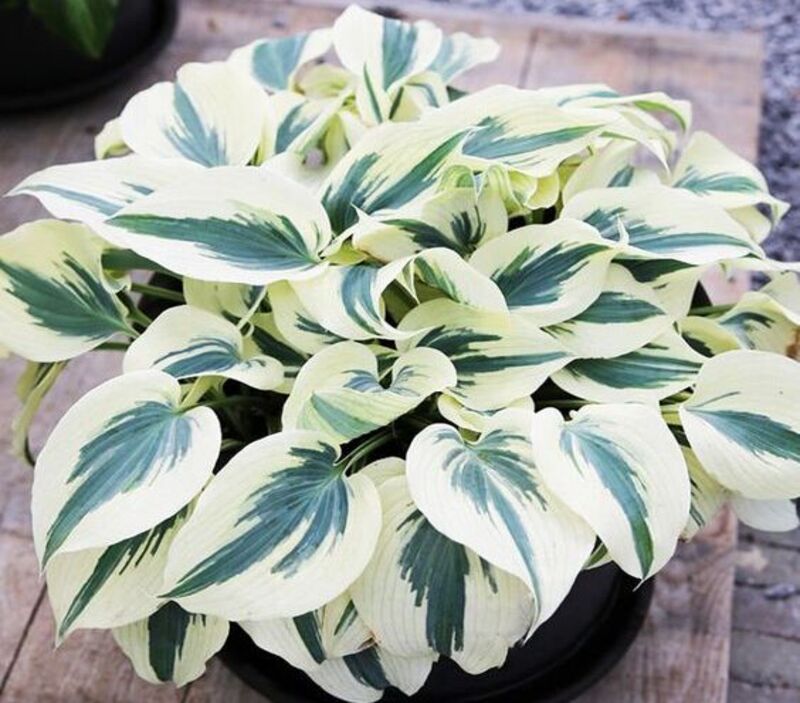
Styling and Design of Bonsai Hosta
Styling and designing a Bonsai Hosta is a creative and rewarding process that can result in a unique and beautiful plant. Here are some tips for styling and designing your Bonsai Hosta:
Consider the plant’s natural growth habit: Bonsai Hosta can be trained into a variety of different shapes and styles, but it’s important to consider the plant’s natural growth habit and choose a style that complements it.
Choose a good container: Although Bonsai Hosta may be grown in a number of containers, it is critical to select one that is well-suited to the plant’s size and form. For a tiny Bonsai Hosta, use a shallow dish or bonsai pot.
Prune the plant regularly: Regular pruning is essential for maintaining the shape and size of your Bonsai Hosta. Use sharp pruning shears to remove any unwanted or overgrown branches or leaves, being careful not to damage the plant.
Train the plant carefully: Bonsai Hosta can be trained into a variety of different shapes and styles using wiring or other techniques. Be patient and take your time as you work to shape the plant, making small adjustments over time to achieve the desired result.
Consider the overall design: The overall design of your Bonsai Hosta should be visually appealing and well-balanced. Consider the placement of branches, leaves, and other features to create a pleasing and harmonious composition.
Use accessories to enhance the design: Accessories such as rocks, moss, and figurines can be used to enhance the design of your Bonsai Hosta and create a more interesting and visually appealing display.
Overall, styling and designing a Bonsai Hosta requires careful attention to detail and a creative approach. By taking the time to choose the right container, prune the plant regularly, and train it carefully, you can create a unique and beautiful Bonsai Hosta that will be a joy to admire and care for.
How to Care for a Bonsai Hosta
Caring for a Bonsai Hosta requires attention to detail and a commitment to providing the plant with the right conditions for growth and development. Here are some tips for caring for your Bonsai Hosta:
- Watering: Bonsai Hosta needs regular watering, but it’s important not to overwater or underwater the plant. Water the plant thoroughly when the soil feels dry to the touch, but be careful not to let the soil become waterlogged.
- Fertilization: Bonsai Hosta requires regular fertilization to ensure healthy growth and development. Use a balanced, slow-release fertilizer formulated for bonsai plants, and apply it according to the instructions on the package.
- Light: Direct sunlight or too much shade can harm bonsai hosta, which prefers partial shade or filtered sunlight. Place the plant in a location that receives bright, indirect light for several hours each day.
- Temperature: Bonsai Hosta is a tough plant that can withstand a broad variety of temperatures, although it likes a temperate climate with temperatures ranging from 60 to 80°F (15 to 26°C). Avoid subjecting the plant to severe temperatures or sudden temperature fluctuations.
- Soil: Bonsai Hosta prefers well-draining, slightly acidic soil that is rich in organic matter. Use a bonsai-specific soil mix or a high-quality potting soil with added perlite or sand for drainage.
- Pruning: Regular pruning is essential for maintaining the shape and size of your Bonsai Hosta. Use sharp pruning shears to remove any unwanted or overgrown branches or leaves, being careful not to damage the plant.
- Pest control: Aphids, spider mites, and slugs are among the pests that attack Bonsai Hosta. Inspect the plant on a regular basis for symptoms of pest infestations and, if required, employ organic pest control measures such as neem oil or insecticidal soap.
By providing your Bonsai Hosta with the right care and attention, you can ensure that it thrives and remains healthy for years to come.
Bonsai Hosta Care Sheet
| Aspect | Care Tips |
| Watering | Water thoroughly when soil feels dry to the touch |
| Fertilization | Use balanced, slow-release fertilizer for bonsai plants |
| Light | Prefers partial shade or filtered sunlight |
| Temperature | Moderate climate with temperatures between 60-80°F (15-26°C) |
| Soil | Well-draining, slightly acidic soil rich in organic matter |
| Pruning | Regular pruning to maintain shape and size |
| Pest control | Regularly inspect for pests and use organic pest control methods such as neem oil or insecticidal soap if necessary |
Remember that the specific care needs of your Bonsai Hosta may vary depending on factors such as its size, age, and growing conditions. By paying close attention to your plant’s needs and providing it with the right care and attention, you can help it thrive and flourish for years to come.
Conclusion
Bonsai Hosta is a one-of-a-kind and lovely addition to any yard or house. Bonsai Hosta may grow as a tiny plant in a small container with proper care and attention. Bonsai gardening is a pleasant and enjoyable activity that may bring a sense of fulfillment and relaxation to anybody who tries it.
FAQ:
Q: What is Bonsai Hosta?
A: Bonsai Hosta is a miniature version of the Hosta plant that has been trained and pruned to grow in a small container, giving it a unique and striking appearance.
Q: Can Bonsai Hosta be grown indoors?
A: Yes, Bonsai Hosta can be grown indoors as long as it is provided with sufficient light and the right growing conditions.
Q: How often should I water my Bonsai Hosta?
A: Water your Bonsai Hosta thoroughly when the soil feels dry to the touch, but be careful not to overwater or underwater the plant.
Q: What type of soil is best for Bonsai Hosta?
A: Bonsai Hosta prefers well-draining, slightly acidic soil that is rich in organic matter. Use a bonsai-specific soil mix or a high-quality potting soil with added perlite or sand for drainage.
Q: Can Bonsai Hosta be pruned?
A: Yes, regular pruning is essential for maintaining the shape and size of your Bonsai Hosta. Use sharp pruning shears to remove any unwanted or overgrown branches or leaves, being careful not to damage the plant.
Q: What type of fertilizer should I use for Bonsai Hosta?
A: Use a balanced, slow-release fertilizer formulated for bonsai plants and apply it according to the instructions on the package.
Q: Is Bonsai Hosta susceptible to pests and diseases?
A: Yes, aphids, spider mites, and slugs are among the pests that can attack Bonsai Hosta. Inspect the plant on a regular basis for symptoms of pest infestations and, if required, employ organic pest control measures such as neem oil or insecticidal soap.
Also Read:

